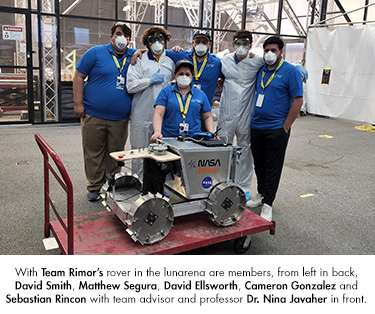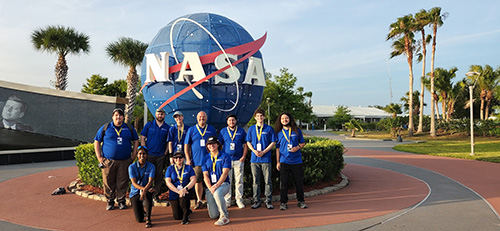 Lone Star College-CyFair’s inaugural NASA lunabotics team returned from the Kennedy Space Center with life lessons learned, a standing ovation and a special recognition after their excavation rover prototype arrived at the Florida competition broken and with missing pieces.
Lone Star College-CyFair’s inaugural NASA lunabotics team returned from the Kennedy Space Center with life lessons learned, a standing ovation and a special recognition after their excavation rover prototype arrived at the Florida competition broken and with missing pieces.
“I am so proud of Team Rimor, who regrouped, got the rover to a functional state on day two and successfully passed all inspections required before entering the competition arena,” said team advisor and Professor Dr. Nina Javaher. “When all was said and done, they not only received a special recognition at the awards ceremony, the Robotic On-site Perseverance Award, but a standing ovation from NASA engineers, judges and other teams, for powering through, refabricating and reprogramming the rover during competition.”
NASA senior project manager Richard Johanboeke also praised the team and commented on their systems engineering performance, work ethic and perseverance.
“They acted like engineers. They had a problem to solve and they did their best to solve it,” he said. “I told them to take great pride in themselves, in the manner in which they acted while here.”
Members of LSC-CyFair’s Team Rimor, one of 48 teams from prominent colleges and universities at the spring NASA Robotics Mining Competition (RMC), included David Smith (team lead), David Ellsworth (lead on fabrication), Matthew Segura (lead of robotics programming and automation), Arial Lucas, Freddy Seeberger, Cameron Gonzalez, Shalom Victor, Sebastian Rincon and Kyle Randall.
 “The thing that will stick with me long after this project is over is how working as a team can get so much more accomplished than on your own,” said Smith. “The project was a labor of love and while the team worked tirelessly, it would not have been possible without the support of our faculty advisors and LSC administration.”
“The thing that will stick with me long after this project is over is how working as a team can get so much more accomplished than on your own,” said Smith. “The project was a labor of love and while the team worked tirelessly, it would not have been possible without the support of our faculty advisors and LSC administration.”
Currently in LSC-CyFair’s Bachelor of Applied Technology in Cybersecurity program, Smith, who has more than a decade in the non-profit sector, said he plans to use his skills, talents and education to become a chief information officer or chief security officer in that field.
“I have already began implementing aspects of system engineering in my professional duties as a system administrator over the past year and it has been very impactful,” said Smith.
He added that the faculty mentorship was crucial to the project’s success and helped his professional growth immensely and leadership skills picked up from advisors will be useful during the entirety of his career.
“The (RMC) project also allowed me to meet interesting people with diverse skillsets and backgrounds that I would have never had the chance to encounter,” said this active member of the college’s Robotics Club and Women in Science Technology Engineering Math (STEM) organization.
The RMC is part of NASA’s Artemis Student Challenge designed to train students in the methods of NASA systems engineering while designing, building, and operating a lunar excavator prototype using teleoperation and various levels of autonomy and artificial intelligence.
While preparing for the competition, Team Rimor also raised awareness about NASA's Artemis mission at the Gulf Coast Regional Science Olympiad, at James Williams Elementary's Hoedown event and in a Service Learning STEM program, said Dr. Javaher.
Email Nina.Javaher@LoneStar.edu for information.
Registration for fall classes starting Aug. 29 is underway. For information, go to LoneStar.edu/regcyfair or LoneStar.edu/registration.

